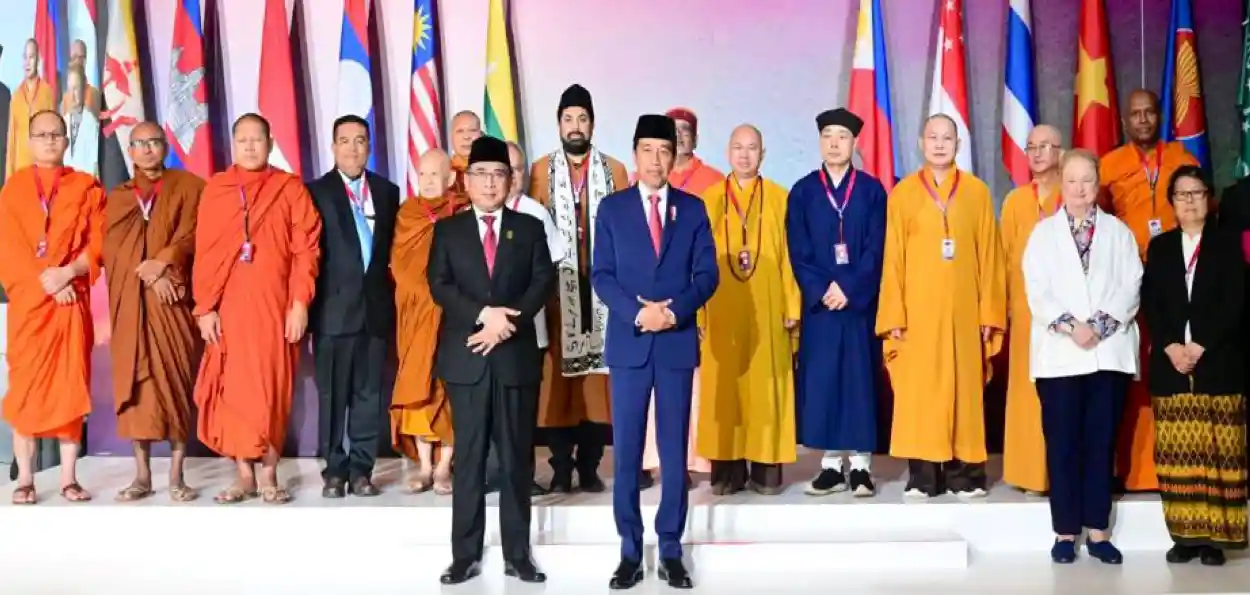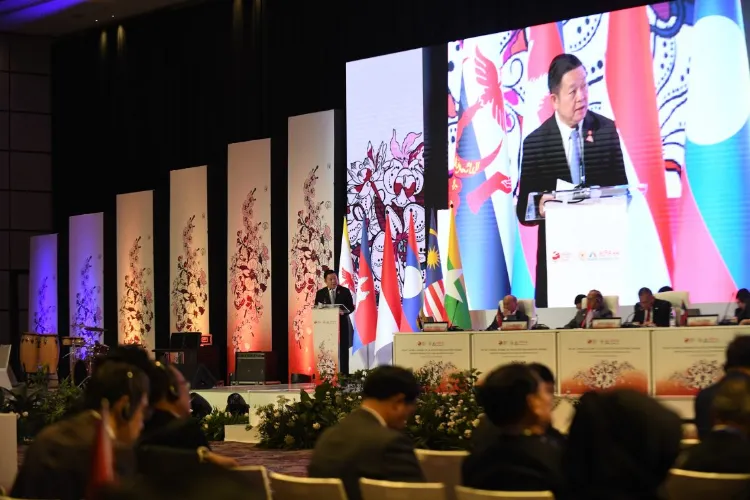
New Delhi/Jakarta
India, with its rich history and heritage, has long been a beautiful mix of cultures and religions. The pluralistic fabric of our nation is a testament to the values of tolerance and coexistence. We believe that dialogue is the path to greater understanding and peaceful coexistence. In a world that faces many challenges, including religious and cultural misunderstandings, it is our collective responsibility to promote inclusion and celebrate diversity. By engaging in meaningful conversation, we can identify common values that bind us as human beings and develop solutions to address common concerns.
Haji Syed Salman Chishtiy, prominent Indian Sufi spiritual leader and, Chairman of Chishty Foundation, said that the ASEAN Conference was held in Jakarta, the capital of Indonesia, which was organized for ". aims to create a center of coordination to promote peace, security, and prosperity
Addressing the conference, he said that on behalf of India, I am honored to address this prestigious ASEAN Summit for Inter-religious and Inter-Cultural Dialogue under the theme"ASEAN Common Cultural Values.” We need to come together as a region to promote understanding, respect, and harmony between diverse cultures and faiths. Through this dialogue, we seek to build bridges and break down walls of ignorance and prejudice. Together, we can create an environment where all communities can thrive, preserving their unique identities while embracing the wider human family.”
He said that India is committed to playing an active role in promoting interfaith and intercultural harmony in the ASEAN region. “We will continue to support initiatives that encourage mutual respect, promote education about different cultures and beliefs, and strengthen social cohesion. We hope that this summit will be a springboard for lasting partnerships and cooperation.” He said THE summit would act as a catalyst in a more peaceful, tolerant, and prosperous future for all ASEAN countries.
In his long speech, he highlighted various qualities of India and said that the ASEAN region has experienced various historical and cultural influences, including India. These influences mainly arise from India's historical trade, cultural exchange, and religious interactions with Southeast Asian countries. He said that Indian influence in the ASEAN region can be seen from many aspects.
.webp)
Syed Salman Chisty withe other leders ay the inter=religious conferenc in Jakarta
Chisty said that Islam, Hinduism, and Buddhism played an important role in shaping the religious landscape of many Southeast Asian countries like Indonesia, Cambodia, Thailand, and Myanmar. Many ancient temples and religious structures reflect architectural and artistic style influences of Indian traditions.
While language and script have also played an important role, Sanskrit is an ancient Indian language. This has influenced the development of script and vocabulary in some Southeast Asian languages. For example, the Khmer script in Cambodia and the Thai script in Thailand have borrowed elements from this ancient script.
In the realm of arts and culture, Indian art forms such as dance, music, and traditional performances have influenced the cultural expression of some ASEAN countries, leading to a unique blend with local traditions.
Not only this but the same similarity in trade and commerce. India has a long history of maritime trade with Southeast Asia, which facilitated the exchange of goods, ideas, and technology between the two regions. It is also worth noting that Ancient sea trade routes connected India to various ports in Southeast Asia, contributing to cultural diffusion and cultural interactions.
Speaking about spirituality and religion, literature and epics cannot be ignored. Indian epics such as the Ramayana and the Mahabharata have deeply influenced the literary and cultural traditions of many Southeast Asian countries. Local versions and adaptations of these epics are often integrated into the folklore and stories of the region.
_xJi_xCz_x4e_NQw_(2).webp)
Syed Salman Chisty withe other leders ay the inter=religious conferenc in Jakarta
Along with this, our traditional medicine and healing methods are worth considering. Ayurveda, the traditional Indian system of medicine, has influenced traditional healing practices in some Southeast Asian countries, leading to the adoption of herbal remedies and holistic health care practices. Influence on Language In addition to the script, Sanskrit has also contributed to the development of the vocabulary of many Southeast Asian languages, particularly in terms of technical and philosophical terms.
Syed Salman Chishty added that festivals and events: Indian festivals such as Diwali, Holi, and Vesak (celebration of Buddha's birth) are celebrated by communities in some ASEAN countries, showing the continued relevance of Indian cultural traditions.
You may recall that throughout history, Indian scholars and teachers traveled to Southeast Asia to impart knowledge and promote intellectual exchange, thereby contributing to the intellectual development of the region.
In terms of contemporary cultural exchange, in recent times, cultural exchange between India and ASEAN countries has been facilitated through diplomatic initiatives, trade agreements, and people-to-people contacts, leading to a deeper understanding of each other's cultures has been promoted.
An important aspect is the architecture. Indian architectural styles, particularly those seen in ancient temples and monuments, have influenced the design and construction of sacred and historic buildings in countries such as Indonesia, Cambodia, and Thailand. For example, the Angkor Wat temple complex in Cambodia features Hindu architectural elements.
Let me remind you that Indian merchants through trade routes played an important role in the historic maritime trade network that connected South Asia with Southeast Asia. The sea routes facilitated the exchange of goods, spices, textiles, and cultural ideas, which helped the development of both regions.
Along with dance and performing arts, traditional Indian dance forms such as Bharatanatyam and Odissi have influenced dance traditions in Southeast Asian countries, resulting in unique dance styles incorporating indigenous and Indian elements. In some ASEAN countries, Indian festivals are celebrated by local communities and integrated into the national cultural calendar. For example, Thai Pongal, a harvest festival celebrated in Tamil Nadu, India, is celebrated by Tamil communities in countries such as Sri Lanka and Malaysia.
Looking at common philosophical and spiritual concepts, Indian philosophical ideas, such as the concepts of karma, dharma, and moksha, have found resonance in the spiritual beliefs and practices of some Southeast Asian societies. Historical evidence also points to the existence of Indian academic centers in Southeast Asia, where scholars from India and the region would gather to exchange knowledge and engage in academic activities. Indian Art and Artifacts: Ancient and contemporary Indian art and artifacts have entered the museums and cultural institutions of ASEAN countries. Cultivating their cultural heritage and creating opportunities for intercultural appreciation.

The inter-religious conference in Jakarta
Syed Salman Chishti added that Indian films, especially Bollywood films, have gained popularity in some Southeast Asian countries, introducing audiences to Indian culture, music, and dance. He added that it is important to note that while these Indian influences have left a lasting impression, the ASEAN region is a diverse cultural, historical, and contemporary influence within and outside Asia. highlights the rich tapestry of interconnectedness and cultural interactions that have shaped the history of the region. As the world evolves, these historical ties continue to play a role in promoting cooperation and understanding between India and the ASEAN countries. These various facets of Indian influence have contributed to the enduring ties between India and the ASEAN region. Reflect.
They have shaped the cultural identity of the region and contributed to mutual appreciation and understanding between India and Southeast Asian countries. As cultures continue to evolve, these historical ties provide a strong foundation for further cooperation and friendships to develop.
Previously, ASEAN Secretary General Dr. Kaw Kim Horn addressed the opening ceremony of the ASEAN Intercultural and Interreligious Dialogue Conference 2023 held at the Ritz Carlton Mega Kuningan in Jakarta, Indonesia. While the President of the Republic of Indonesia Joko Widodo during the ceremony Said opening remarks.
The event was organized by Nahda Ulama Indonesia and supported by the Indonesian government. It was attended by religious and cultural leaders, government officials, members of academic institutions and civil society representatives from ASEAN member states and other countries in the region.
ASEAN Secretary General Dr. Kaw Kim Horn delivered a statement at the 44th General Assembly of the ASEAN Inter-Parliamentary Assembly on the theme: A responsible parliament for a stable and prosperous ASEAN. Dr. Kao encouraged parliamentarians from ASEAN member states to promote socially responsible and sustainable policy-making at both the national and regional levels. He also assured the parliamentarians that the ASEAN Secretariat is ready to cooperate closely and more meaningfully with the Parliamentary Assembly to better contribute to the process of building the ASEAN Community.
